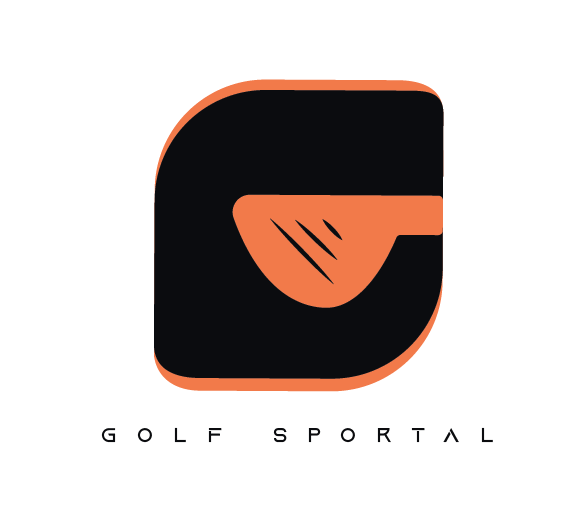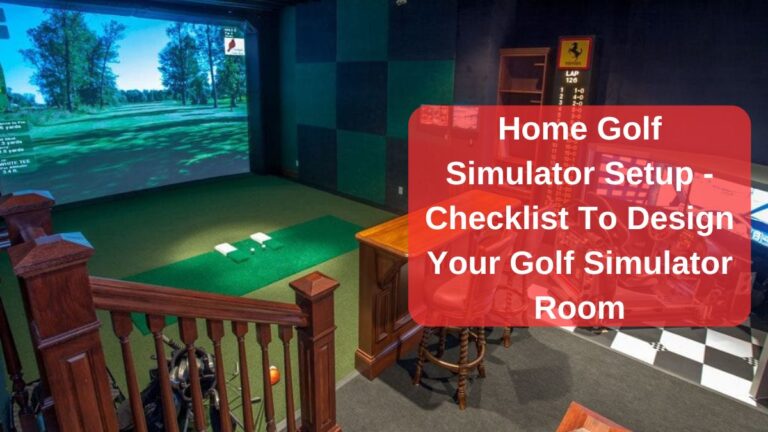What Is A Golf Simulator? A Detailed Guide

Today, I’m going to walk you through what is a golf simulator, how a golf simulator works, step by step, how to set it up properly, and the various benefits it offers for improving your game and overall experience.
A golf simulator is an advanced setup designed to simulate the experience of playing golf indoors. Whether it’s for off-season practice, game improvement, or just a fun way to play rounds of golf without heading to the course, golf simulators are popular among both casual and professional players.
They can be used to work on specific areas of your game, analyze swing data, or even enjoy a virtual round on famous courses from around the world.
How Does a Golf Simulator Work?
Golf simulators use a combination of hardware and software to track a golfer’s swing and ball flight and then project a realistic simulation of where the ball would have gone on a virtual course. Here’s how it breaks down:
1. Input
The golfer takes a shot from a hitting mat, aiming at a large screen or net. Real clubs and balls are used, with sensors placed near the ball or attached to the club to track various metrics.
2. Data Collection
As soon as the ball is hit, a launch monitor tracks key data points such as ball speed, launch angle, spin, and swing path. High-end simulators like TrackMan and SkyTrak provide detailed feedback on these metrics, helping golfers understand their swing.
3. Processing
The collected data is processed to determine the ball’s flight path. This includes the calculation of factors like carry distance, trajectory, and where the ball would land on the virtual course.
4. Output
The shot is displayed on a screen that mimics a real course, complete with topography and environmental conditions. Advanced simulators allow you to play famous golf courses virtually, offering an immersive experience.
| You May Also Like: Golf Simulator Beginner’s Guide |
Key Metrics Tracked by Golf Simulators
| Metric | What It Measures | Why It Matters |
|---|---|---|
| Ball Speed | Speed of the ball immediately after impact | Higher speeds lead to greater distance. |
| Clubhead Speed | Speed of the club as it strikes the ball | Key for increasing ball speed and maximizing distance. |
| Launch Angle | Angle at which the ball leaves the club | Crucial for achieving optimal ball flight and distance. |
| Spin Rate | Revolutions per minute (RPM) of the ball | Affects the ball’s trajectory and how it behaves upon landing. |
| Club Path | Direction the club is traveling during impact | Helps correct slices or hooks. |
| Face Angle | Direction the clubface is pointing at impact | Determines the ball’s initial direction. |
| Smash Factor | Efficiency of energy transfer from club to ball | Higher values mean more efficient shots. |
Different Types of Golf Simulators
- Photometric Simulators: These use high-speed cameras to capture images of the ball and analyze its behavior. Examples include SkyTrak and Foresight GC2.
- Radar-Based Simulators: Systems like TrackMan use radar to measure the ball’s flight. These simulators tend to be more accurate for outdoor use but are also used in high-end indoor setups.
- Infrared Simulators: These use infrared sensors to detect the movement of the club and ball. These are often found in more affordable simulators like OptiShot.
Choosing the Right Simulator

When considering golf simulators, budget is a key factor, as they can range anywhere from $500 to $50,000 or more. Entry-level systems typically provide basic data, while high-end models offer detailed metrics and real-time feedback. The cost or budget for these simulators will be discussed in more detail later in this article.
Another important consideration is space requirements. It is essential to ensure you have enough room for the setup, particularly when it comes to swinging clubs. Most systems require at least 8 to 10 feet of ceiling height to accommodate full swings.
Accuracy is also a major difference between systems. Higher-end models like TrackMan and SkyTrak are known for their superior accuracy, especially when it comes to tracking both club and ball data.
You May Also Like: How To Setup Golf Simulator Enclosure Size
Why Should You Use a Golf Simulator?
Golf simulators aren’t just for entertainment—they offer significant benefits for improving your game:
- Year-Round Practice: No matter the weather, you can keep practicing your swing.
- Data-Driven Improvement: By analyzing metrics such as ball speed, club path, and spin rate, you can get a clearer picture of your strengths and weaknesses.
- Convenience: With a golf simulator at home, you don’t need to travel to the driving range or course to practice.
- Fun: You can play virtual rounds on some of the most famous courses in the world, adding a layer of excitement to practice sessions.
Where Can I Set Up a Golf Simulator?
Setting up a golf simulator requires ample space, whether in your basement, garage, or a dedicated room. The ideal dimensions are typically:
- At least 9-10 feet, depending on your swing and the clubs you use.
- Around 12-15 feet to accommodate swings from both right- and left-handed players.
- A minimum of 12-15 feet to ensure there’s enough distance for the ball to travel before hitting the screen or net.
If space is tight, you can opt for a portable setup using a net and a smaller hitting area. For example, some golfers use setups where the simulator projects the shot data onto a nearby TV instead of a large screen.
Also Read: Golf Simulator Projector Setup
Benefits of Using a Golf Simulator

Improving Your Swing: Golf simulators allow for focused practice with instant feedback. You can quickly correct issues like swing path or clubface angle.
Consistency: Regular practice in a controlled environment helps improve muscle memory and consistency.
Learning Your Distances: Knowing exactly how far you hit each club can make a big difference in the course.
Mental Practice: Simulators can replicate different course conditions, helping you develop mental strategies for dealing with challenging shots.
Challenges and Limitations
While golf simulators are excellent for practice, there are some limitations:
Short Game: Simulators struggle to replicate the delicate nature of chipping and putting on real greens.
Realism: While highly accurate, simulators can’t perfectly mimic outdoor conditions such as wind, uneven lines, or grass friction.
Space and Cost: High-end simulators can be expensive, and not everyone has the space for a full-scale setup.
You May Also Like: 10 Must-Have Golf Simulator Accessories
Major Components – Setting Up a Golf Simulator at Home
Here’s what you’ll need to set up a basic golf simulator:
Launch Monitor: This tracks the ball’s flight and provides data on each shot. Popular options include SkyTrak, Mevo+, and TrackMan.
Hitting Mat: A high-quality mat replicates the feel of hitting off the grass and protects your floor. Some top brands include Fiberbuilt and TrueStrike.
Net or Impact Screen: If you’re using a projector, you’ll need an impact screen to display the course and stop the ball. Alternatively, a net is a cheaper, space-saving option.
Computer/Tablet: You’ll need a device to run the simulator software, such as a gaming PC or tablet.
Projector (Optional): For the most immersive experience, project the simulation onto a large screen.
How Much Does a Golf Simulator Cost?
Golf simulators range widely in price, depending on the features and accuracy of the system. Entry-level systems like OptiShot start at around $500, while high-end systems like TrackMan or Full Swing can cost more than $50,000. (These prices may vary)
- Entry-Level: $500 – $2,500 (OptiShot, Rapsodo)
- Mid-Range: $2,500 – $10,000 (SkyTrak, Mevo+)
- High-End: $10,000+ (TrackMan, Foresight GCQuad)
| Read This Article To Know More About The Cost Of A Golf Simulator! |
Basic Home Simulator Setup Costs (Estimated Costs)
| Item | Estimated Cost |
|---|---|
| Launch Monitor | $500 – $20,000 |
| Hitting Mat | $150 – $1,000 |
| Net or Impact Screen | $200 – $1,500 |
| Projector | $300 – $2,000 (Optional) |
| Computer/Tablet | $500 – $1,500 |
| Software | $300 – $1,000 (Annual Fee) |
Our Tricks to Improve The Game with a Golf Simulator
- Work on Your Weaknesses: Use the simulator to focus on specific areas, like driving accuracy or approach shots.
- Pay Attention to Data: Metrics like club path and face angle can help you fine-tune your swing mechanics.
- Simulate Course Conditions: Practice on simulated courses that challenge your game. This helps build confidence when you face similar situations in real courses.
- Use Video Review: Record your swing and compare it with the data to see where you can make improvements.
FAQs
Can I use any golf ball with a simulator?
Yes, most simulators allow the use of any ball, but some might perform better with specially designed-balls for accuracy.
Do golf simulators help improve your short game?
Simulators are great for full swings, but chipping and putting can feel less realistic.
How much space do I need for a golf simulator?
A room with a minimum of 10 feet in ceiling height, 12 feet in width, and 15 feet in depth is ideal for most setups.
These Topics Might Interest You:
- Golf Simulator Hitting Mat Guide
- Golf Simulator Vs. Launch Monitor
- How Realistic Is A Golf Simulator?
- How To Start A Golf Simulator Business
- Home Golf Simulator Room Design Ideas
- Are There Special Balls For A Golf Simulator?

I’m Khawar Iqbal, Founder of Golfsportal. I’m excited to be your guide in the world of Golf. At Golfsportal, I will keep you updated with insightful information that will help you improve your golfing experience and knowledge about what’s currently happening in the industry.






